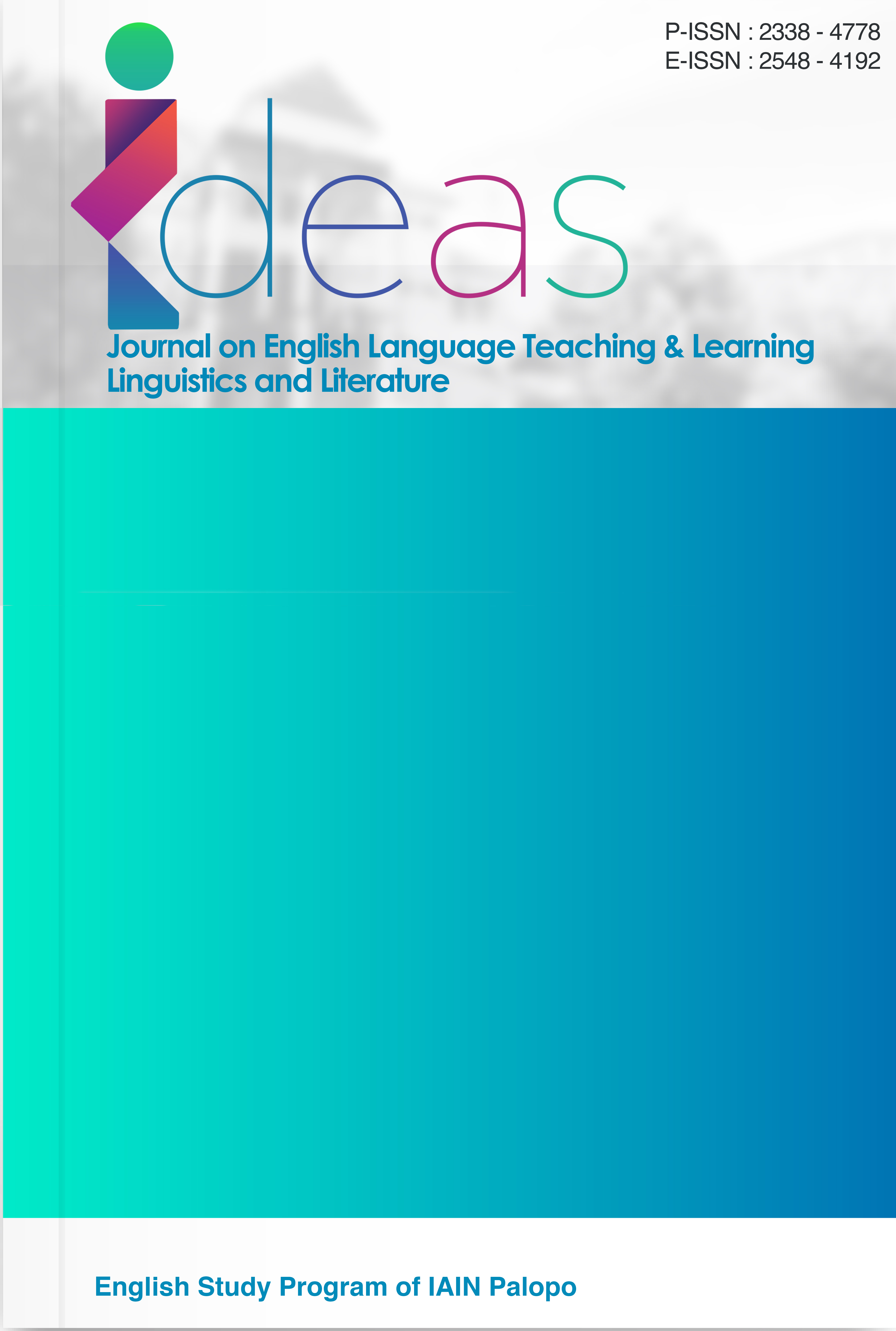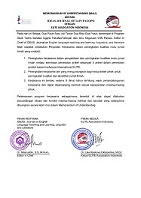The Language Style Used by YouTuber Bailey Sarian in Chris Watts – 2000 Page Discovery Murder, Mystery & Makeup
DOI:
https://doi.org/10.24256/ideas.v13i2.7893Keywords:
Bailey Sarian; Language Style; Martin JoosAbstract
This research analyzed the language style used by YouTuber Bailey Sarian in the video “Chris Watts – 2000 Page Discovery Murder, Mystery & Makeup” using Martin Joos's (1967) language style theory, which classified language styles into five types: frozen, formal, consultative, casual, and intimate. The purpose of this research is to determine what language style Bailey used in that video and which language style is dominant. Using descriptive qualitative methods, the document data collection technique, Miles and Huberman’s model analysis technique, and analytical template, the researcher identified and analyzed the video transcript, resulting in a total of 253 data, consisting of 5 formal styles, 113 consultative styles, 133 casual styles, and 2 intimate styles. The results show that Bailey Sarian uses informal and flexible language, making the storytelling more engaging, easy to understand, and emotionally resonant, while still maintaining its informative purpose. No frozen language styles were found in the analyzed data. It can be seen that the dominant language style used was casual. This research concluded that the appropriate language style served an important role in the effectiveness of storytelling content on social media such as YouTube.
References
Asmarandhana, G. L., Putri, E. N., Nisa, H. L., Irandani, E., Hadafi, A., & Nurhayati, E. (2023). Analisis Gaya Bahasa Dalam Lirik Lagu “Hati-Hati di Jalan” Karya Tulus (Kajian Stilistika). Semantik : Jurnal Riset Ilmu Pendidikan, Bahasa Dan Budaya, 1(4), 192–200. https://doi.org/https://doi.org/10.61132/semantik.v1i4.136
Brown, M. J., Pullon, S., McKinlay, E., Gray, L., & Darlow, B. (2022). Template Analysis of a Longitudinal Interprofessional Survey: Making Sense of Free-Text Comments Collected Over Time. Journal of Research in Interprofessional Practice and Education, 12(1). https://doi.org/https://doi.org/10.22230/jripe.2022v12n1a337
Dewi, R. S., & Aulina, R. (2022). Investigating Language Style Used By Atta Halilintar in His Youtube Channel. Indonesian Journal of Education, Social Sciences and Research (IJESSR), 3(1), 12–17. ttp://jurnal.umsu.ac.id/index.php/ijessr%09
Diego, Lestari, Y., & Sarmiati. (2024). From Tweets to Thrills : The Evolution of Digital Storytelling on YouTube through Nessie Judge ’ s Horror Narratives. PIKMA: Jurnal Publikasi Ilmu Komunikasi Media Dan Cinema, 7(1), 24–36.
Fatmawati, E. (2015). Media Baru Digital Storytelling di Perpustakaan. LIBRARIA: Jurnal Ilmu Perpustakaan Dan Informasi, 4(2), 105–117.
HERMANSYAH, S. (2023). Investigating Difficulties Faced by Lecturers in Teaching General English . Journal of English Education and Teaching, 7(3), 499–509. https://doi.org/10.33369/jeet.7.3.499-509
Joos, M. (1967). THE FIVE CLOCKS: A Linguistic Excursion Into the Five Styles of English Usage. Harcourt, Brace & World, Inc.
Keraf, G. (1991). Diksi dan Gaya Bahasa (Cetakan ke). PT Gramedia Pustaka Utama.
Larasati, S. (2022). Penggunaan Gaya Bahasa Personifikasi Pada Konten Youtube Nadia Omara: Kisah Horror Wawak 25 Part. Universitas Islam Sultan Agung.
Meidiana, & Astuti, P. P. (2024). Language Style Found in Guillermo del Toro’s Pinocchio Movie (2022). Journal of Pragmatics Research, 6(1), 74–88. https://doi.org/10.18326/jopr.v6i1.74-88
Mudinillah, A., Kuswandi, D. ., Erwin, E., Sugiarni, S., Winarno, W., Annajmi, A., & Hermansah, S. (2024). Optimizing Project-Based Learning in Developing 21st Century Skills: A Future Education Perspective. Qubahan Academic Journal, 4(2), 86–101. https://doi.org/10.48161/qaj.v4n2a352
Oktavia, A. S. (2017). Mengenal Gaya Bahasa dan Peribahasa. CV. Rasi Terbit. https://books.google.co.id/books?id=2NryDwAAQBAJ&lpg=PA3&ots=pJlVGjDVip&dq=buku gaya bahasa&lr&pg=PA4#v=onepage&q=buku gaya bahasa&f=false
Oviogun, P. V., & Veerdee, P. S. (2020). Definition of language and linguistics: basic competence. Macrolinguistics and Microlinguistics, 1(1), 1–12.
Sam Hermansyah, & Ahmad Rizal Majid. (2025). The Use of Probing-Prompting Technique to Improve Reading Comprehension of Eighth Grade Students. INTERACTION: Jurnal Pendidikan Bahasa, 12(1), 543–556. https://doi.org/10.36232/interactionjournal.v12i1.2660
Sari, Y. P., Missriani, M., & Wandiyo, W. (2021). Analisis Gaya Bahasa Pada Film Dilan 1990 Karya Pidi Baiq. Jurnal Pembahsi (Pembelajaran Bahasa Dan Sastra Indonesia), 11(1). https://doi.org/http://dx.doi.org/10.31851/pembahsi.v11i1.43167
Sarian, B. (n.d.). Bailey Sarian. Linkedin. https://www.linkedin.com/in/bailey-sarian-38196a40
Sugiyono. (2010). Metode Penelitian Pendidikan (Pendekatan Kuantitatif, Kualitatif, dan R&D) (10th ed.). ALFABETA, cv.
Susilo, Y. N. (2020). Efektivitas Penggunaan Digital Storytelling Kanal Youtube “Ilmu komunikasi UNJ” Dalam Meningkatkan Keterampilan Komunikasi. JIKE : Jurnal Ilmu Komunikasi Efek, 4(1), 68–77. https://e-journal.umc.ac.id/index.php/jike/index Abstract
Wanji, M., Firmansyah, M., Gulo, D. R. S. B., Azzahra, Z. N., & Mujiatun, S. (2025). Penerapan Metode Deduktif dan Induktif dalam Manajemen. Jurnal Manajemen Dan Pendidikan Agama Islam, 3(2), 239–250. https://doi.org/https://doi.org/10.61132/jmpai.v3i2.990
We Are Social. (n.d.). We Are Social. https://wearesocial.com/id/
Wiratno, T., & Santosa, R. (2014). Bahasa, Fungsi Bahasa, dan Konteks Sosial. In Pengantar Linguistik Umum (pp. 1–19). Universitas Terbuka.
Downloads
Published
Issue
Section
Citation Check
License
Copyright (c) 2025 Putri Wulandari Nurul Azmi, Shalehoddin, Adam, Juwita Boneka Sinaga

This work is licensed under a Creative Commons Attribution-ShareAlike 4.0 International License.
Authors retain copyright and grant the journal right of first publication with the work simultaneously licensed under an Attribution-ShareAlike 4.0 International (CC BY-SA 4.0) that allows others to share the work with an acknowledgement of the work's authorship and initial publication in this journal.
Authors are able to enter into separate, additional contractual arrangements for the non-exclusive distribution of the journal's published version of the work (e.g., post it to an institutional repository or publish it in a book), with an acknowledgement of its initial publication in this journal.
Authors are permitted and encouraged to post their work online (e.g., in institutional repositories or on their website) prior to and during the submission process, as it can lead to productive exchanges, as well as earlier and greater citation of published work (See the Effect of Open Access)




